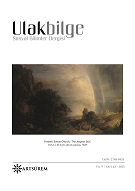Eril Egemen Yapının Sanatsal Bağlamda Dişil Formu
Female Form of Male Dominant Structure in Artistic Context
Author(s): Tolga Akalın, Mehtap KurtSubject(s): Gender Studies, Visual Arts, Aesthetics, Social differentiation, Sociology of Art
Published by: Sanat ve Dil Araştırmaları Enstitüsü
Keywords: Masculinity/femininity; male statement and work of art; social gender and art;
Summary/Abstract: Women have always been the subject of art in terms of their biological and physiological characteristics. The compositions that are shaped in accordance with contents have different nuances in terms of form according to the cultural structure in the arts of civilizations with functional practices and sub-meaning interpretations. Despite this, they have common characteristics in terms of woman/body/sexuality on social duty and classification. Such that male domination social gender roles, gender discrimination based on biology bring along some restrictions and exclusion, and that degrades women to the subject of scopophilic. Gender structure in art is exposed with unfair visual codes, disadvantageous images, improper female circumstances and erotic nudity in many compositions. Women body that is turned into a theatrical material, their identity and gender are abstracted, their image, representation, symbol and government connetion shows the demands of male dominant structure. In this frame, the aim of this study is to analyze the affect of gender roles, patterns, the woman themed art pieces in historical process that is oriented towards structuring, building a sustainable woman perception in male dominant systems of societies on art history. Accordingly, the study is important in terms of showing the systematical dominances on woman identity, body, sexuality created by male dominant sense of art and art literature research in terms of turning femininity into a different construction other than its natural positions and clarifying the problem of re-naming and re-structuring the position of woman and body today. Literature research and descriptive research methods are used in this study. Related visuals and written resources are analyzed and the parts that are related to the content of this article are handled in a manner that creates meaningful unity.
Journal: Ulakbilge Sosyal Bilimler Dergisi
- Issue Year: 9/2021
- Issue No: 62
- Page Range: 994-1009
- Page Count: 16
- Language: Turkish

